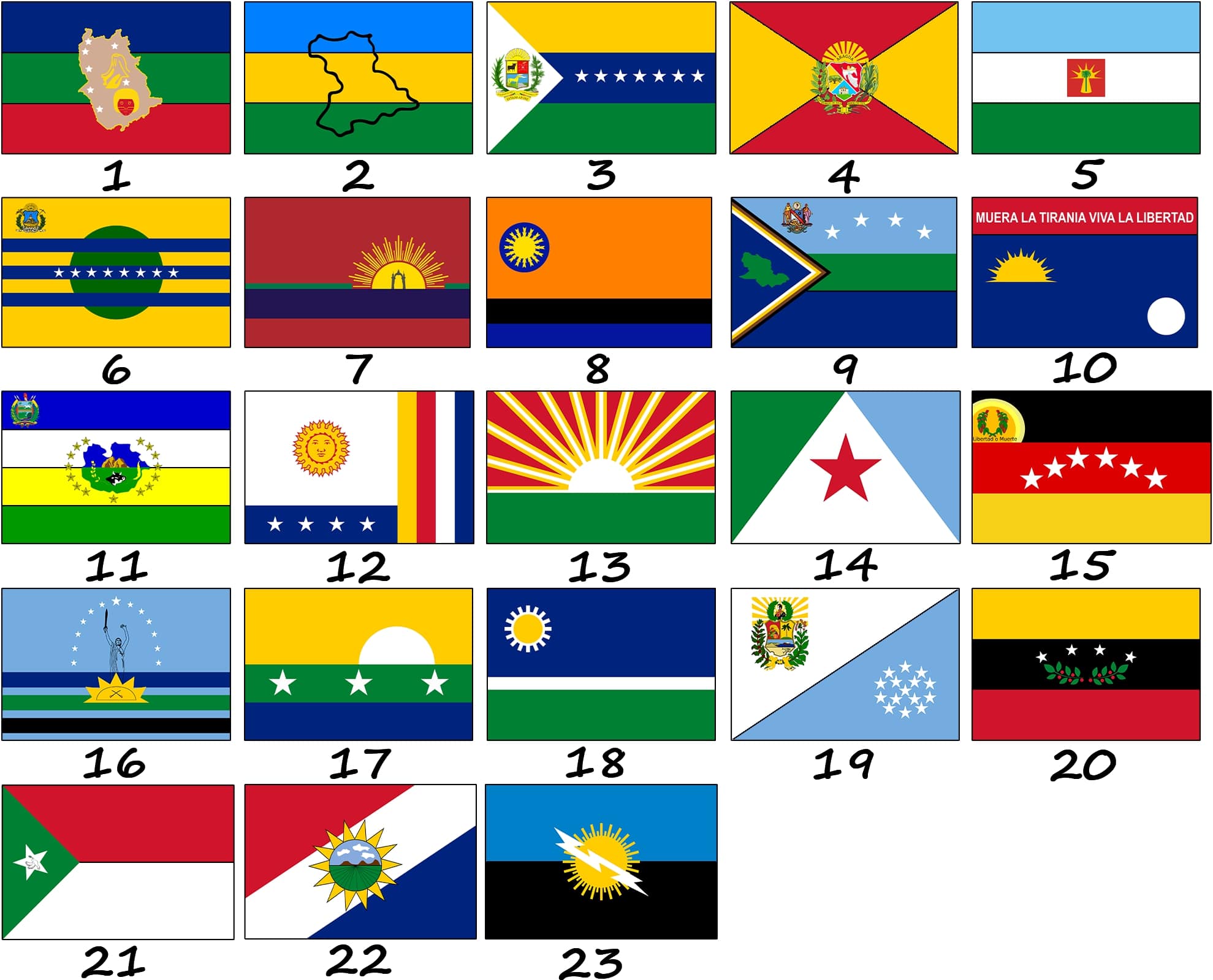In 1797, the flag was designed by Manuel Gual, symbolizing the homeland, equality before the law, and different ethnic groups. It consists of a sun, a blue stripe with four white stars, and four vertical stripes of yellow, red, white, and blue. The Guala flag became the official flag of the state of Vargas(12) in 2001. The Miranda flag, designed by Francisco de Miranda in 1800, consists of three horizontal stripes of black, red and yellow, representing different ethnic groups. In 2006, the Miranda flag became the official flag of the state of Miranda(15) and received six stars symbolizing the state's regions. The flags of Guaya and Miranda are symbols of the liberation movement in Venezuela.
In 1806, during an expedition through Coro and Ocumare, Francisco de Miranda raised a rectangular flag on a blue background, symbolizing the sky and the sea. In the center was a white moon with a human face, symbolizing the fall of Spanish power. In the upper left corner was a sun with a red face, which was an image of American freedom. The red stripe of the flag bore the inscription "MUERA LA TIRANÍA Y VIVA LA LIBERTAD" (DEATH TO TYRANNY AND LONG LIVE LIBERTY). A similar flag has been used by the state of Falcon(10) since 2004, only the sun and moon have lost their human form and are depicted in white and yellow colors.
In Venezuela, the yellow-blue-red flag, which is the original emblem of the current flag, was first deployed in Fort San Pedro on August 3, 1806.
In 1811, a new design of the Venezuelan flag was created. This flag had yellow, blue, and red stripes, and in the upper left corner was an Indian holding a Phrygian cap surrounded by an alligator and plants. The flag was first raised on July 14, 1811. This flag became a symbol of Venezuela's independence and the American continent.

On May 12, 1817, a decree of the Federal Government formed in Pampatar established the use of a tricolor flag with seven stars representing the united provinces of Venezuela. This flag was to be used on warships and merchant ships of the republic. After Simon Bolivar's victory in the Guayana campaign, a new star appeared on the flag of the federal government, representing the liberated province of Guyana. This brought the number of stars on the flag to eight.
On October 4, 1821, it was established that the flag of Greater Colombia would be the same as the flag of Venezuela, except that the image of the Indian was replaced by the coat of arms of New Granada. The coat of arms consists of a condor on a blue background holding a pomegranate and a sword in its talons. The bird is surrounded by a laurel wreath, with two ribbons that have the motto "Vixit e Vincit et amore patriae" (I live and conquer the love of the Motherland), and are connected to the star of the Liberators. Below is a full moon with ten stars.

In 1824, the flag of the Great Republic of Colombia was changed. It consisted of a tricolor and a coat of arms on a blue stripe. This coat of arms was formed by two horns of plenty, which reflected strength and unity. Below are spears with a bow and arrows. The coat of arms is surrounded by a circle that reads "Republic of Colombia". This flag was introduced after the liberation of Ecuador and Peru and the creation of Bolivia.
On October 14, 1830, the Constituent Congress, which met in Valencia, adopted the flag of the Republic of Venezuela, retaining the tricolor with horizontal stripes but changing the coat of arms. The coat of arms was temporarily the same as that of Colombia, but with the horns of plenty turned upside down and the inscription "Estado de Venezuela", later replaced by "República de Venezuela". On April 20, 1836, the Venezuelan Congress decided to reform the state coat of arms and approved a new national flag, which featured three equal stripes and the new coat of arms of Venezuela in the upper left corner.

General Juan Cristóstomo Falcon, who became President of Venezuela after the Federal Revolution, established the national flag by decree on July 29, 1863. The flag consists of horizontal stripes of yellow, blue, and red, arranged in order from top to bottom. On the blue cloth are seven stars, six of which form a circle, and the seventh is in the middle of the circle.
In 1905, the national flag of Venezuela, introduced on July 5, 1811 by the provinces, was approved. The flag consists of horizontal stripes of yellow, blue and red, with seven stars in a circle in the middle of the blue stripe. In 1930, during the reign of Juan Vicente Gómez, a law was passed that changed the design of the flag, removing the stars from the central blue stripe and leaving only the tricolor. In 1954, under the presidency of Marcos Pérez Jiménez, a law on the flag, coat of arms, and national anthem was passed. The flag acquired a look close to the modern one - a tricolor with an arc of seven white stars.

By a legislative decree of March 7, 2006, the National Assembly of Venezuela repealed the Flag, Coat of Arms and National Anthem Law of February 17, 1954, and amended the design of the new flag. The new flag has an additional star to symbolize the inclusion of the province of Guayana in the national flag, as desired by Simon Bolivar in 1819.








